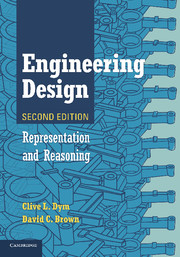Book contents
- Frontmatter
- Contents
- Preface
- Preface to the First Edition
- Acknowledgments
- 1 Framing the Issues
- 2 Engineering Design
- 3 Characterizing the Design Process
- 4 Taxonomies of Engineering Design
- 5 Representing Designed Artifacts
- 6 Representing Design Processes
- 7 Where Do We Go from Here?
- References Listed in First Edition
- New References
- Index
Preface to the First Edition
Published online by Cambridge University Press: 05 June 2012
- Frontmatter
- Contents
- Preface
- Preface to the First Edition
- Acknowledgments
- 1 Framing the Issues
- 2 Engineering Design
- 3 Characterizing the Design Process
- 4 Taxonomies of Engineering Design
- 5 Representing Designed Artifacts
- 6 Representing Design Processes
- 7 Where Do We Go from Here?
- References Listed in First Edition
- New References
- Index
Summary
Design is a central activity in engineering. Indeed, Herbert A. Simon has argued that design is the central activity that defines engineering – or, at the very least, distinguishes it from the “pure” sciences – because the role of engineering is the creation of artifacts. And yet, many of us within the engineering community believe that design is a misunderstood activity that is not well represented in engineering education or research. We are very much aware that engineering science dominates the intellectual landscape of engineering today, and it is certainly arguable that analysis dominates both engineering education and research. Indeed, it has long been a concern that design is improperly taught and inadequately represented in engineering curricula and that too often design is seen as legitimate only when it can be explained in terms of analysis (as in the notion that design is “iterative analysis”).
One of the problems that design educators and design researchers have faced is a perceived lack of rigor, and this perception has in turn led to calls for a more organized, more “scientific” focus to research about design. One aspect of this perception is that design is viewed as a “soft” subject: design is not a “hard” discipline because it is not sufficiently mathematical. Another aspect is that the vocabulary for analyzing and describing design is not shared, even within the design community, although this situation has begun to improve.
- Type
- Chapter
- Information
- Engineering DesignRepresentation and Reasoning, pp. xiii - xviPublisher: Cambridge University PressPrint publication year: 2012



